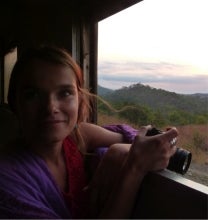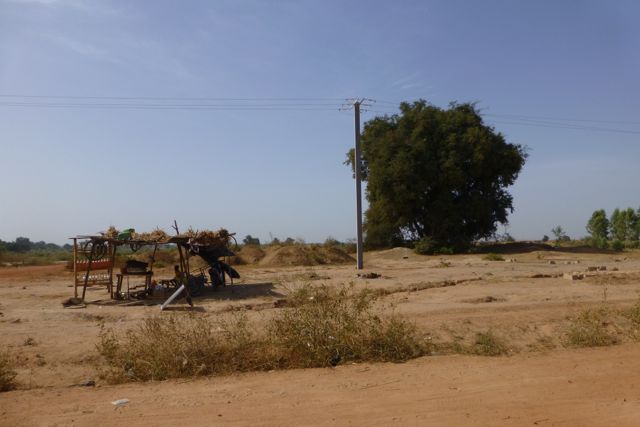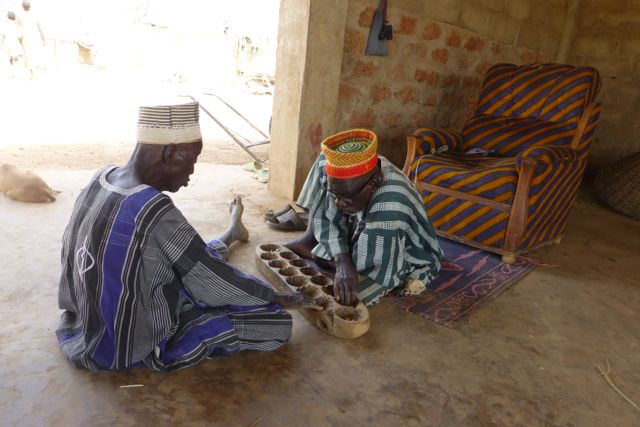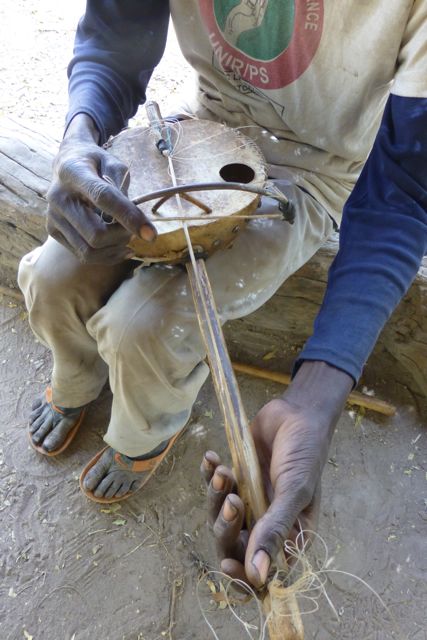A Day in the Brousse

On a particularly bright and sunny morning, my field assistant Sylvain and I left Ouagadougou on the moto to go to a small town in the brousse, where we were supposed to find a fiddle player. I was in Burkina Faso to research the prevalence of fiddles and their role in daily life here. Although much has been written about the myriad varieties of African music and musical instruments - from the Banda Linda horn ensembles to Mande kora music, from harps in Central Africa to the mbira of the Shona in Zimbabwe-, relatively little attention has been paid to fiddles in Africa.[1] I had come to Burkina Faso to discover whether this was a true representation of the role of this instrument in Burkinabé society.
So far I had heard that the traditional Moosé (Mossi) fiddle, the ruudga, was mainly played by blind people to make a living – in rather various locations and circumstances: from local beer bars to the royal court where they perform for the chef du village. On the one hand living in the margins of society, but on the other held in high esteem through their performances for Burkinabé royalty – their ambiguous position fascinated me.
The trip started pleasantly enough, the driving wind providing some welcome coolness. We were speeding along the highway out of town, sharing the road with countless motos, bicycles, ramshackle cars and crowded minibuses with all kinds of loads strapped to the roof - large plastic buckets, bags of millet, furniture, woven baskets, mattresses, and live goats tied upside down, their bellies exposed to the sun. As we took a turn to the left we suddenly found ourselves on a red dirt road, seemingly leading to nowhere. The landscape was desolate here, the endless horizon interrupted by sparse baobab trees – and at one point a gas station, which consisted of a thatched roof with bottles of various sizes containing petrol underneath. It must have been doing business, but it made for an amusing sight since the only traffic we had encountered so far was a donkey cart stacked with firewood.

After a couple hours of driving along the dusty road we arrived in a small village, where we were supposed to find the ruudga player. Sylvain explained to me that we had to stop and ask for permission of the chef du village to enter and to speak with the musician. We made our way up to the royal palace, consisting of a large compound with small houses made of wattle and daub dotted around it. There was a large thatched roof attached to an open brick building, providing shelter against the ruthless sun. Two men were sitting on the floor underneath it, playing the popular bao game.

One of the men had descended from what seemed to be the only chair on the premises onto a sitting mat, and my guess that this was the chef du village was confirmed by Sylvain: apparently a mat, although on the floor, signifies the higher status of the person sitting on it. After introducing ourselves Sylvain inquired about the ruudga player, and it turned out that the musician had indeed been in the village earlier, but that he had now moved to another village, about an hour’s drive away from here. We bade the chef goodbye -though we would have to pass by him again when we came back, a formal ritual- and went on our way.
As we approached another small village on the way, we came across some sort of celebration, with many people who had been drinking gathering around us, shouting and dancing. I didn’t quite understand what was going on, and Sylvain didn’t succeed in explaining it to me either, probably because my brain was working more slowly in this heat. It was however a welcome interruption to the monotony of driving on a dusty road.
After another hour or so we arrived in the small village of Bantogodo, where the ruudga player was said to be. We introduced ourselves and asked for the musician. We were told that he had been here only half an hour ago, but that he had left again. A young man offered to go and look for him, and in the meantime we were offered a seat on a tree trunk underneath a shelter made of branches and palm leaves, which we gratefully accepted. The air felt like warm water filling my lungs, making it difficult to breathe deeply. It seemed very quiet here, I saw a couple of children playing in the shade of another small shelter, and some chickens kicking up the dust.
And then, finally, the ruudga player was brought to us, guided carefully as he was blind. He was wearing wide khaki pants, orange flip-flops, a T-shirt that must have been white once, and sunglasses, perhaps to protect his eyes from the sun or to hide the appearance of his eyes. The young man helped the musician sit down, and I introduced myself in French while Sylvain translated (most people in Burkina Faso speak French, however in smaller towns and villages people prefer to speak their regional language, Moosé in this case). The musician introduced himself as Joacin Souli, aged 52, and told me he started to play the ruudga 35 years ago because of his blindness. That the ruudga is the instrument of choice for visually impaired people made sense to me, as it is relatively easy to construct, play, and carry around from one location to another, and it is possible to sing and play at the same time. Joacin told me he is self-educated and as he improvises everything, he is able to adapt the songs he performs to the context. I learned that he plays at festivals, celebrations such as weddings, and markets to earn some money, and performs regularly for the chef du village. The themes of fiddle songs typically vary from topical and social comments at markets and in beer houses, love and life events at celebrations and praise songs at the royal court (see also DjeDje 2008). During a performance the audience may show their appreciation by putting money in the soundhole of the ruudga. By performing at these different occasions, Joacin is not only able to make a living and to be financially independent, but he is also well known in this area because he plays at the palace. While he technically belongs to the lower class of his society, at the same time he is highly valued because of his performances at the court.[2]
The ambiguity of the social position of a ruudga player is reflected in the instrument as well. During my fieldwork I observed that on the one hand musicians attribute special powers to their fiddle and believe that miracles can happen through its music. The performances that the musician has done with his instrument on different occasions are absorbed into the instrument, thereby turning the object itself into an embodiment of experiences. This causes musicians to develop a great attachment to their instrument and a disinclination to dispose of it. I experienced this when expressing interest in acquiring the fiddle of one of my other informants for our museum. The musician did not want to sell his instrument at any cost, but instead agreed to construct a new fiddle exactly like his own. It was the perfect solution: he retained the special powers of his instrument, while our museum received a morphologically identical fiddle by the same maker[3] (special powers would be lost in a museum anyway). On the other hand, many people are convinced that playing the ruudga can in fact cause blindness. The frequent characteristic of visual impairment of its players is attributed to the instrument, ascribing a degree of agency to it: the ruudga is not simply seen as a passive artifact that produces sounds, but as an agent that exerts powers over its players (see also Bates 2012).
Joacin then showed me his ruudga, which he had constructed himself. The resonator consisted of half a calabash, covered with goat skin which was nailed to the gourd with large metal tacks, and secured around the edges with irregular sewing. There was one soundhole in the membrane, and a single string made of nylon, running over a bridge consisting of a triangular shaped twig. He had used metal to construct his bow -as opposed to the more common wooden bows- thereby minimizing the risk of breaking.

As our conversation progressed, more and more people started to gather around us, barefoot children in shorts, women with colourful pagnes wrapped around their waists, men in Western style shirts. The village had seemed so small when we arrived and now I wondered where they all came from. Were they coming to see and hear Joacin? Or was it the rarity of a foreigner in the village that drew them to our spot? In any case the presence of a crowd increased the feeling of attending a ‘real’ performance as Joacin agreed to perform several pieces for us and allowed me to videotape them. Below is a fragment of one of his songs:
While fiddles in Africa may be underrepresented in the Western discourse on African music, the story of Joacin illustrates that the ruudga plays a rather important role in Burkinabé society. Not only is it an instrument which can be used on manifold occasions, it also enables people who would otherwise be relegated to the economic fringe of society to make a living and to increase their social status by performing in front of the royal class.
Carolien Hulshof holds an MA in Musicology from the University of Amsterdam. She currently works as a researcher at the Musical Instruments Museum in Brussels, Belgium, where she leads the research project The Formalized Fiddle, funded by POD Science Policy. For this project, digital data on fiddles from all over the world are gathered and analyzed on similarities, differences, evolutions and migrations. In the framework of the project she has travelled to Burkina Faso, Tanzania and Congo-Brazzaville, to research the prevalence and role of the fiddle in Africa. For more information, see http://www.mim.be/the-formalized-fiddle. Promotor: Dr. Saskia Willaert
References
Bates, Eliot. 2012. “The social life of musical instruments.” Ethnomusicology 56/3: 363-395.
Charry, Eric. 2000. Mande Music.Traditional and Modern Music of the Maninka and Mandinka of Western Africa. Chicago and London: The University of Chicago Press.
DjeDje, Jacqueline Cogdell. 2008. Fiddling in West Africa. Touching the Spirit in Fulbe, Hausa, and Dagbamba Cultures. Bloomington and Indianapolis: Indiana University Press.
Makubuya, James. 2000. “‘Endingidi’ (tube fiddle) of Uganda. Its adaptation and significance among the Baganda.” Galpin Society Journal LIII: 140-155.
Schöpf, Jürgen. 2008. The Serankure and Music in Tlôkweng, Botswana. Berlin: VWB Verlag.
Glossary
Brousse Bush, savannah-like landscape
Chef du village Respected head of a village
Moto Small motorbike
Pagne Long rectangular piece of fabric, often decorated with brightly coloured
patterns
[1] There are several recent publications on fiddles in Africa, see for example DjeDje 2008, Schöpf 2008 and Makubuya 2000, but most information on African fiddles is scattered across various articles and books on African instruments in general.
[2] An ambiguous social position of musicians is not uncommon in Africa, see for example Charry 2000 p. 96-111 on jelis (griots) in West-Africa. I would like to add, however, that in contrast with griots, ruudga players are not born into their profession.
[3] To see this fiddle, visit the online database of the mim





